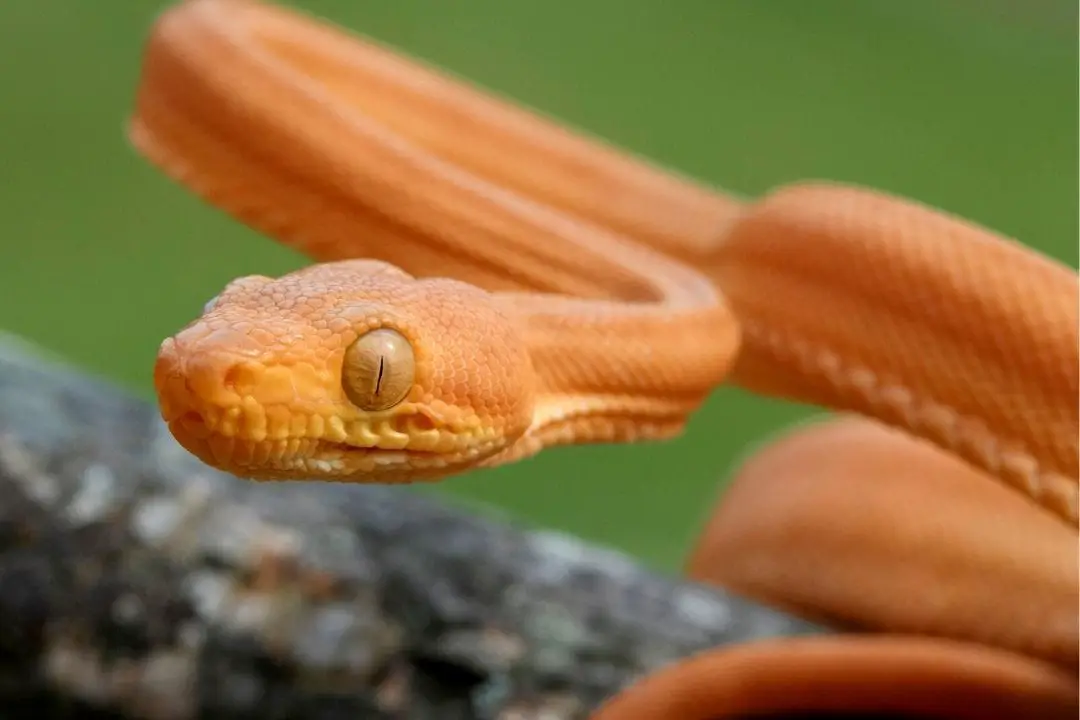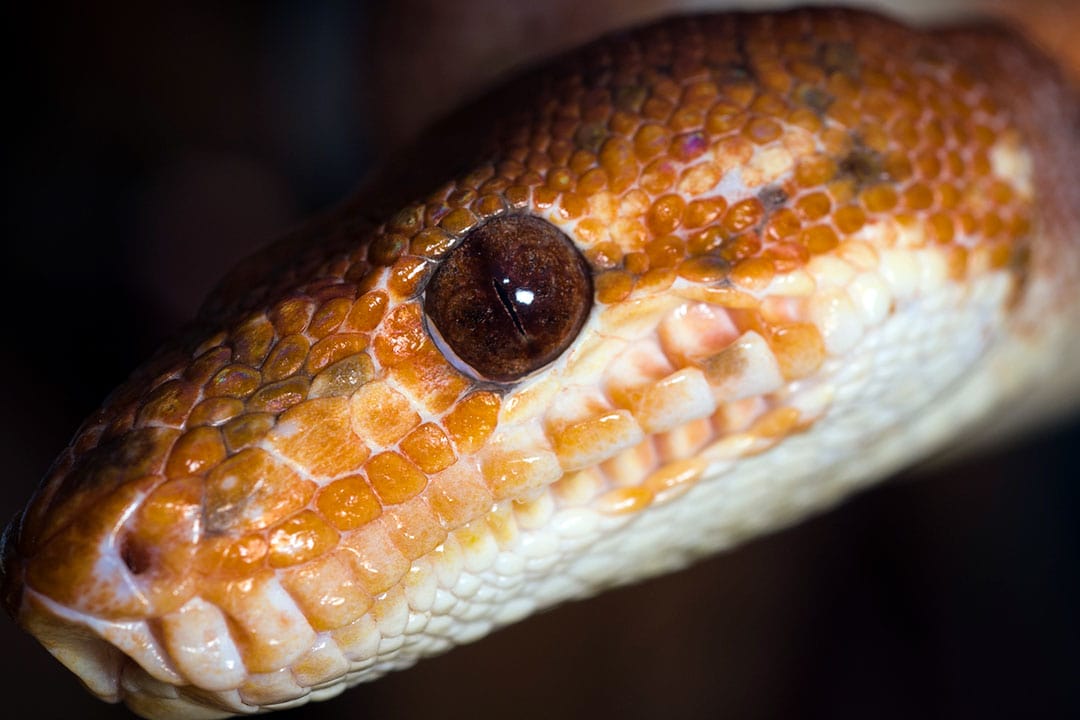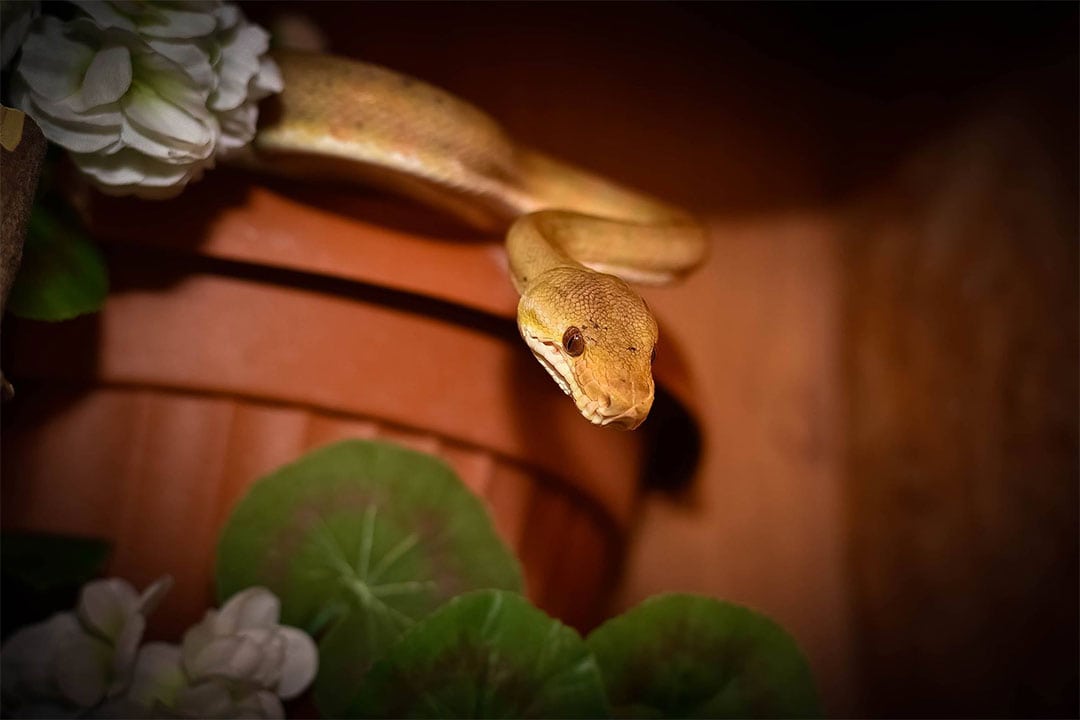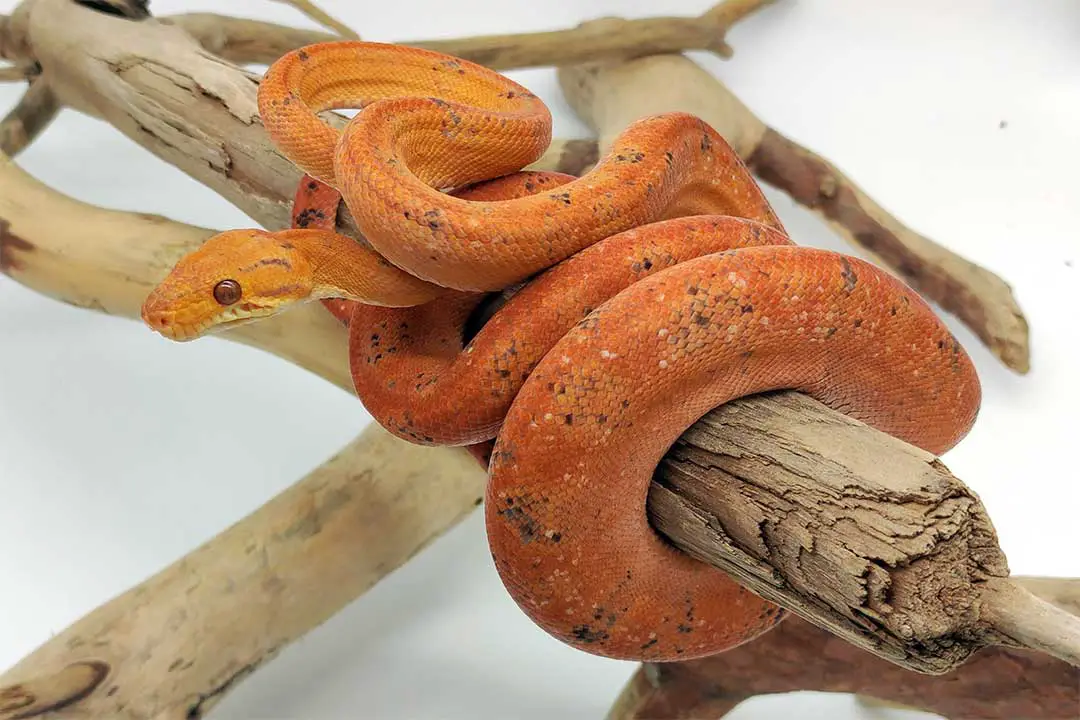The Amazon tree boa (Corallus hortulanus) is an incredible display snake.
They are typically not friendly, but many experienced snake keepers love them for their beautiful colors and habits that encourage these animals to be more visible.
The Amazon tree boa is found throughout the jungles of South America. They range from Brazil to Trinidad depending on the exact subspecies you have.
As the name implies, these animals are arboreal. They can be found ranging through trees. These snakes are very proficient ambush hunters.
A hungry Amazon tree boa will pick a spot and wait for prey to come by. The snake will lunge from its perch to catch food. They have a very strong prey response, so if you want to keep one you should know that you’ll probably get bitten at least once.
Housing
Amazon tree boas require a very different enclosure from the colubrids that are common in captivity. These snakes require vertical space and plenty of climbing surfaces to be happy.
They also require a vertical temperature gradient. We will be going over everything you need to keep these snakes healthy.
Enclosure
Since these are arboreal snakes, they won’t make too much use of floor space. You should focus on the tallest enclosure you can afford and have space for.
Glass is the most common material for enclosures since it can handle the humidity these snakes require. They can be pricey. Wood enclosures can be custom-made to better house this species, but you will need to ensure it is thoroughly sealed or the wood will rot.
Enclosure for Juvenile Amazon Tree Boas
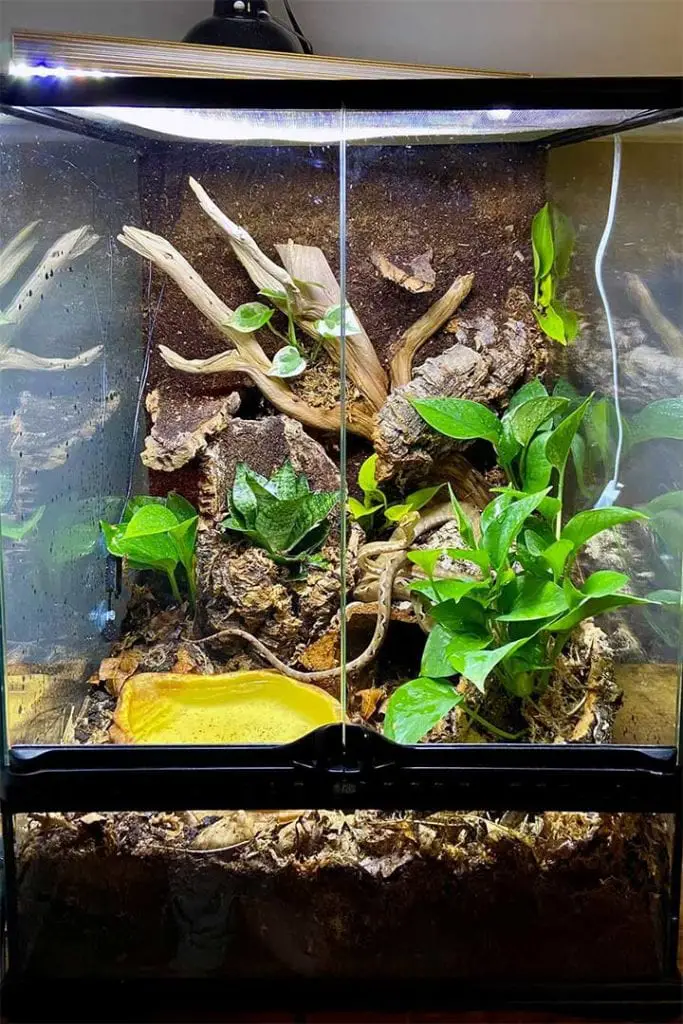
Even babies need a vertical habitat. You will need a tall enclosure that can fit plenty of branches and places to hide for your snake.
Repti Zoo 30 Gallons Arboreal Terrarium
- Separately front-opening doors make you will make feeding your Tree Boa Easier, it will help control escapes as well.
- Well built screen top allows for vertical heating
- Cable pass included to safely install your thermometer and thermostat.
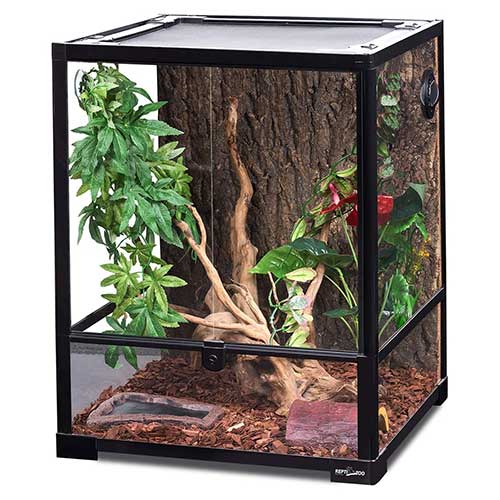
This is a good option. It offers enough space to hold your new snake for quite some time. It also has enough room for hides and a large water dish on the floor and plenty of room for decorations.
You will need space to fit branches or dowels that are at least the width of your snake for it to climb and perch on.
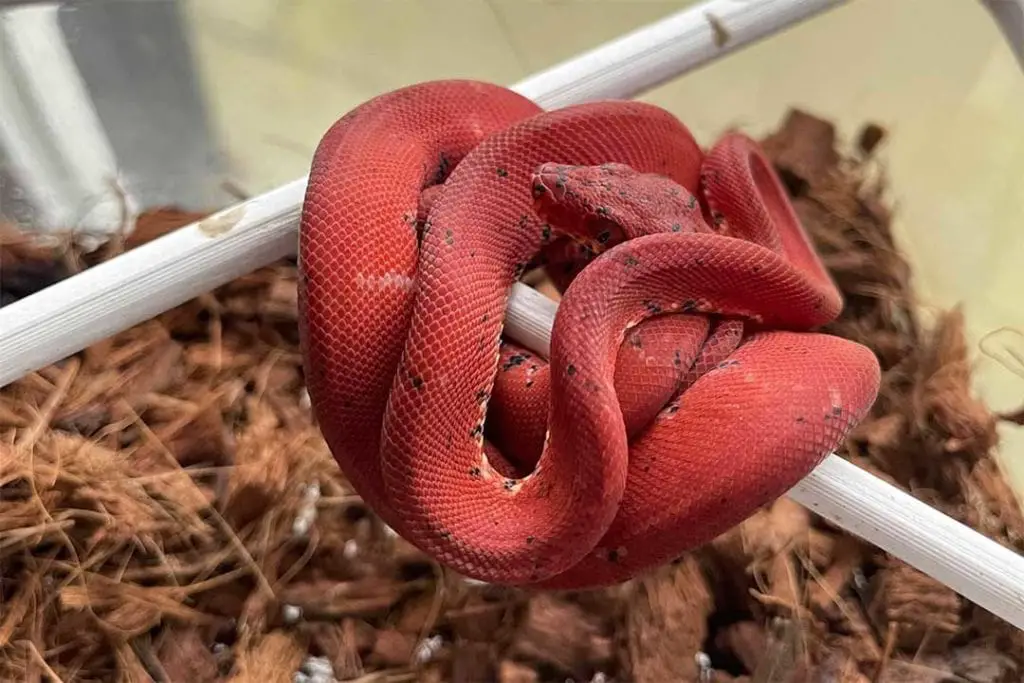
This enclosure also offers a lock, good ventilation, and doors that open from the front so you have an easier time feeding a baby. You will need to replace this once your snake can no longer stretch out about 75% of its body.
Enclosure for Adult Amazon Tree Boas
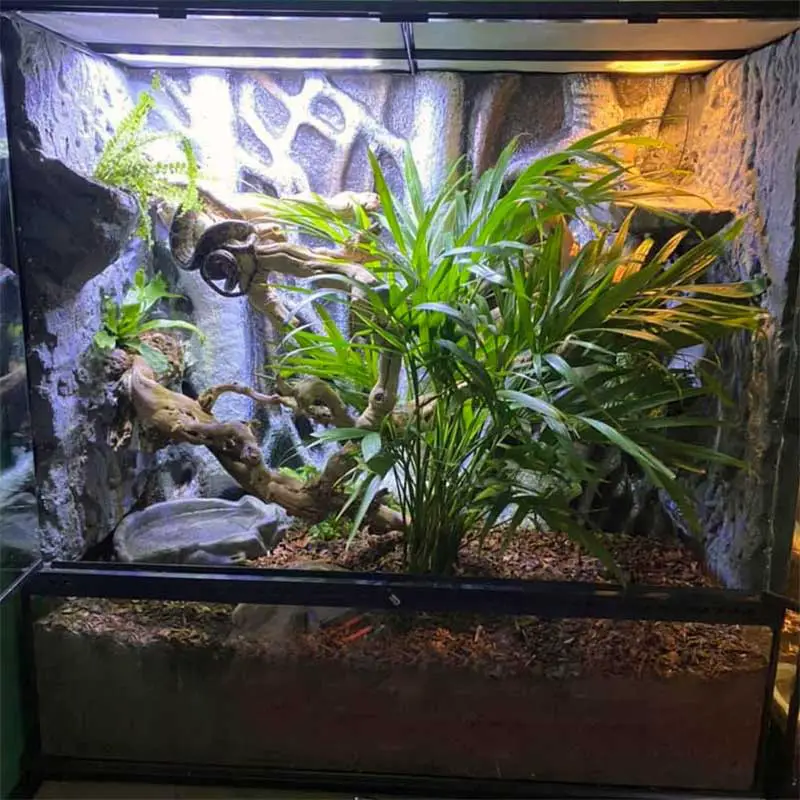
Adult Amazon tree boas require enough space to stretch out at least 80% of their body after a meal. This is to aid digestion, so be sure your snake has an area in your setup that will allow for this.
Adults appreciate more height and will be found moving up and down the enclosure to meet their temperature needs. a 100 gallon terrarium will do.
This is a medium sized snake, you will need room for a hide on the floor, a large water dish, and plenty of cover for your snake.
This is a great option for most snakes. It has plenty of space for decorations and there are secure locks for both the top and the door. It has a nice inlet to allow the cables for your thermometer and hygrometer to be put through the enclosure.
This should also be easy to clean and hold onto humidity fairly well.
Substrate
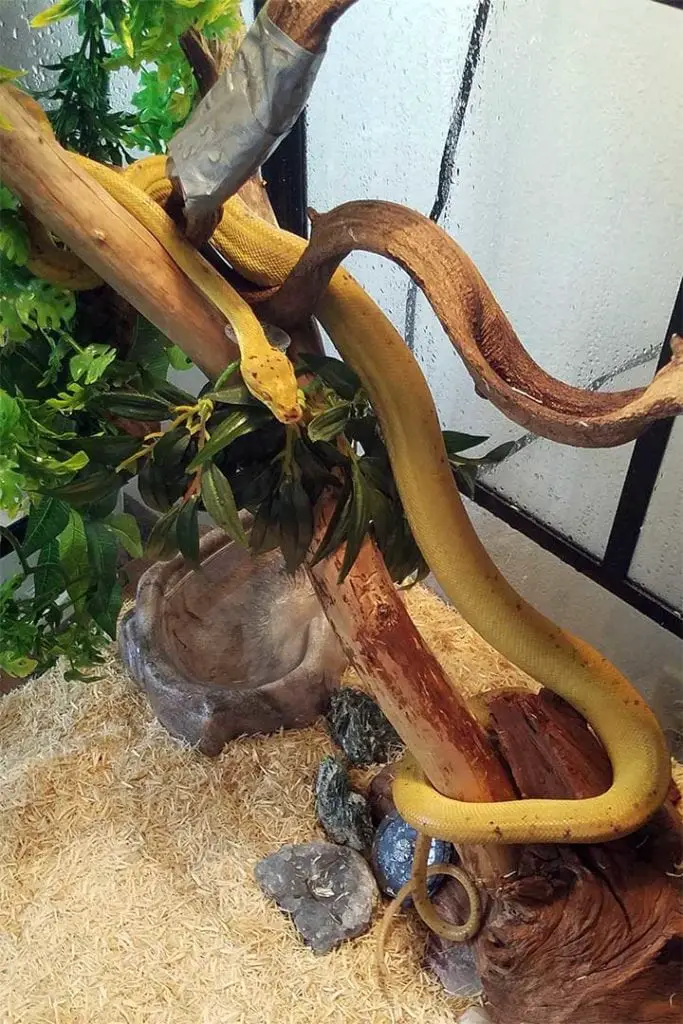
Thanks to the arboreal nature of this species you won’t require a deep substrate layer.
These snakes typically will spend most of their time on the climbing branches, so the substrate is for ease of cleaning up waste and looks. Your main concern will be how well it will hold humidity, you need a slightly moist substrate.
Paper towels and paper are easy to clean up, but not very visually appealing.
Generally, aspen is a good choice for most snakes.
If you feel this is hindering the humidity, you can opt for substates like cypress mulch, orchid bark or coconut husk. Just be sure there are no pesticides and that it is meant for reptiles. Be careful with using low lying vegetation to avoid mold.
You will want to avoid any aromatic wood, dry substrates like sand, and any printed paper since the ink may be unsafe for your snake.
Heating
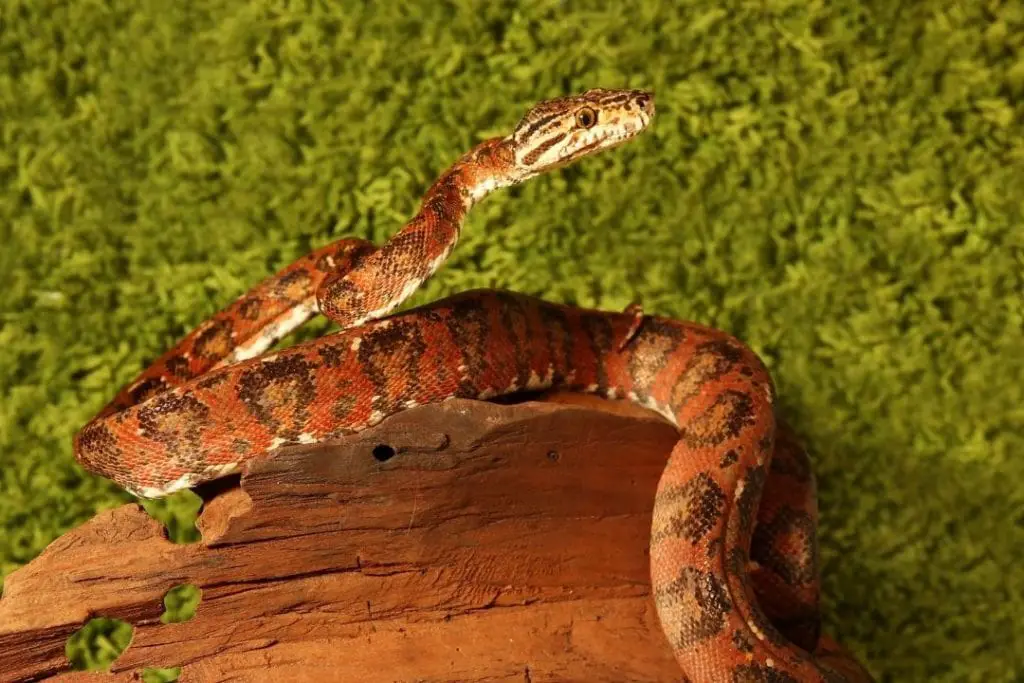
As tropical snakes, the Amazon tree boa will need fairly high temperatures.
You want the ambient temperature in your Amazon Tree Boa’s enclosure to be 80 degrees. The top of the enclosure should be at about 90 degrees and the floor should be around 75 degrees.
This allows your snake to climb to maintain its internal temperature. Remember, all reptiles rely on the temperatures of their surroundings to regulate their body temperature.
Many snakes will benefit from belly heat, and I would recommend heat mats for other types of snakes, for various reasons.
However amazon tree boas will do better with a vertical heat gradient, best provided with basking bulb heat. You should place a ceramic heater in a refector dome to provide heat from above.
Make sure you do not place this inside the enclosure. Your snake will try to lay on it, or hold on to it and can easily get burned by a basking spot. You can use a heat mat if you have trouble keeping the bottom of your enclosure at 75 degrees F.
A thermostat will control your heat source and make sure you do not overheat the tree boa’s enclosure.
Remember to keep an eye on humidity since heat bulbs can dry out enclosures.
Use a thermometer with the sensors placed at a few levels to check what your snake is experiencing. A temperature gun can be used to check the surface temperatures easily so you know exactly what your snake is living in.
Light
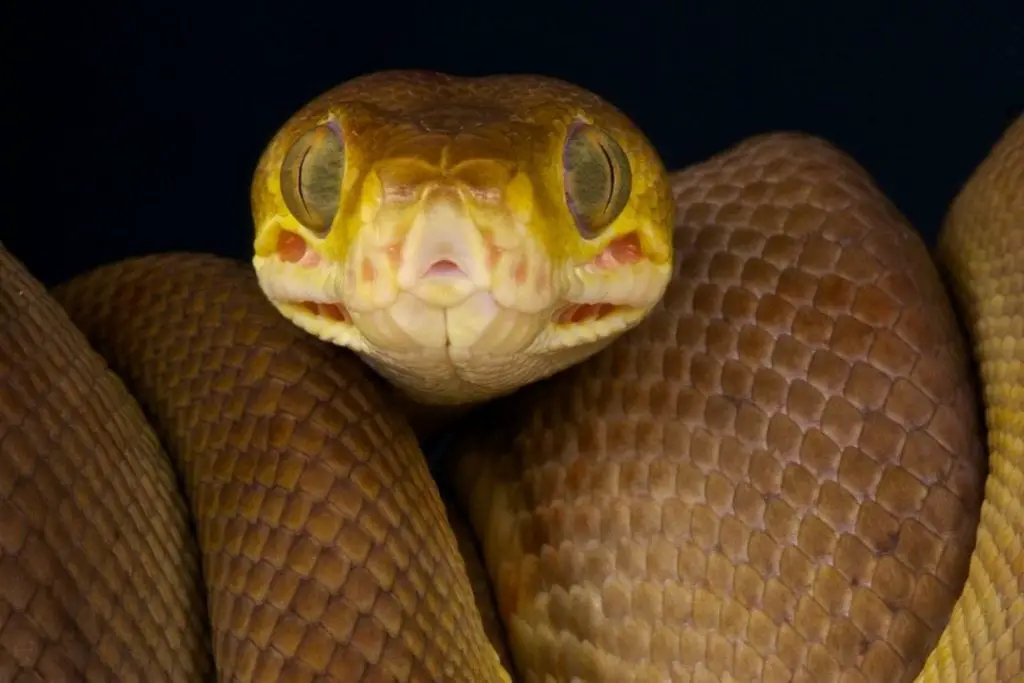
These snakes are typically nocturnal hunters. UV light isn’t necessary. It can actually damage the eyes of the snake. You can use lighting for aesthetic reasons.
Be sure that it doesn’t heat the enclosure and make sure to put it on a 12 hour cycle so your snake has a day and night cycle.
Shelter
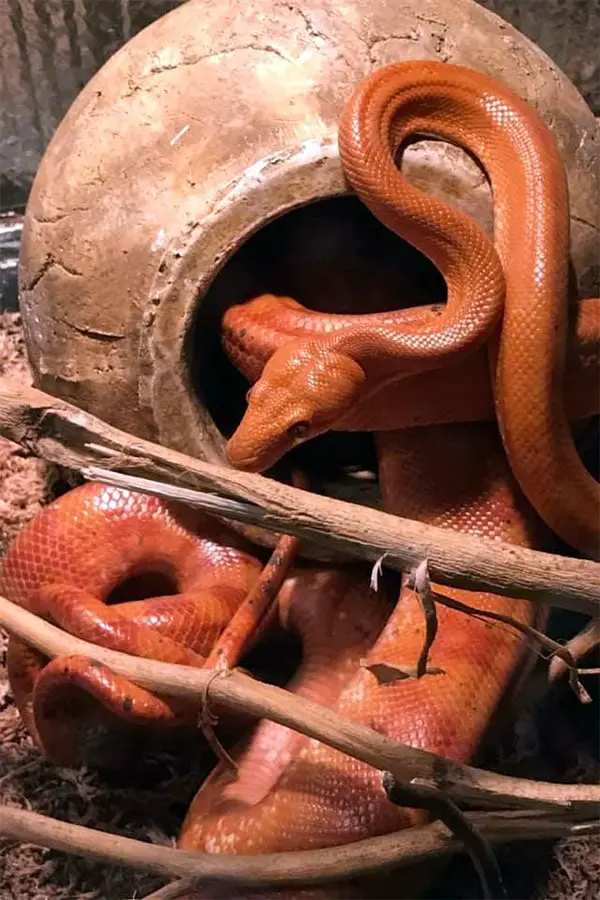
All snakes require the option to feel secure, this is an important part of its habitat setup.
Tree boas will appreciate a hide or two placed on the floor of the enclosure. This is a good example of what you should look for in hide boxes.
Zoo Med Reptile Shelter 3 in 1 Cave, Medium
- Easy to open and clean
- Keeps humidity well for shedding
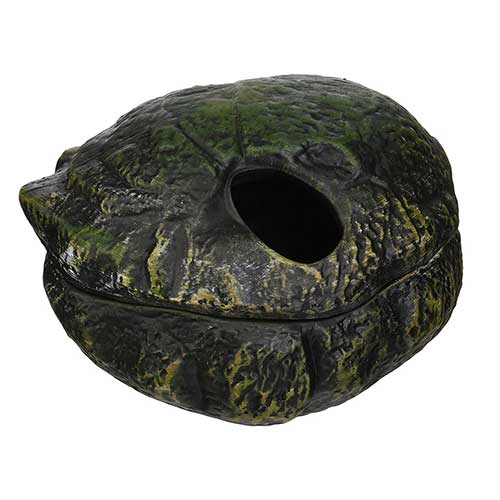
Make sure the whole snake will fit inside the hide box without leaving much room. Many tree boas will enjoy hides placed in the branches so the animal doesn’t need to pick between feeling secure and regulating its temperatures.
Greenery, cork tubes, and even a hide placed higher up can all be offered so your snake can feel safe.
Branches
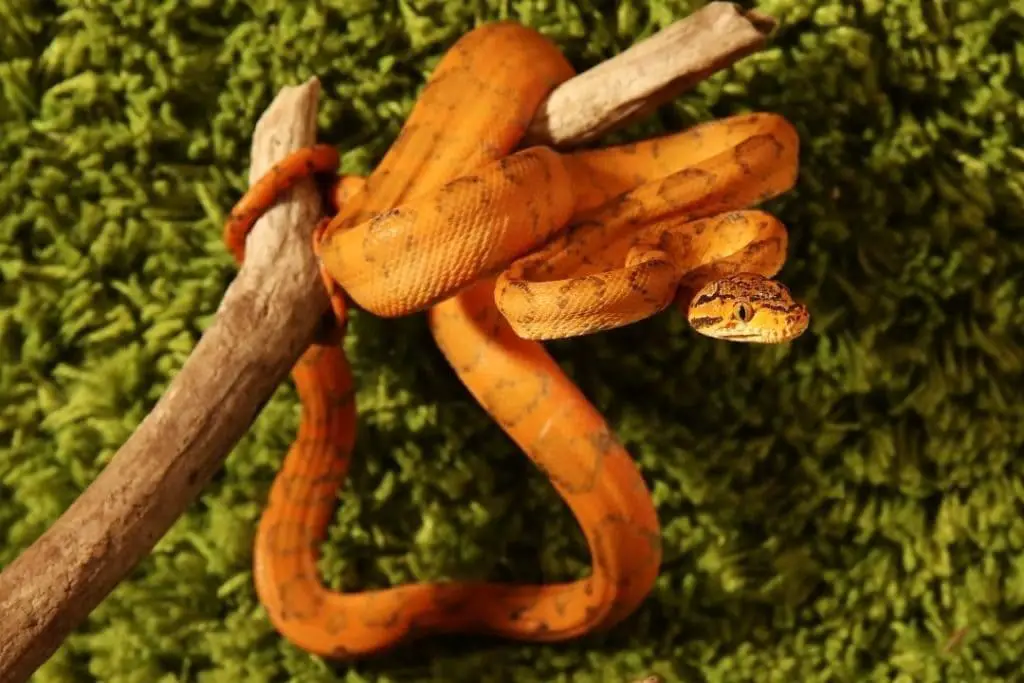
Amazon tree boas are arboreal snake, branches and other climbing structures or artificial foliage are very important for these snakes. These slender snakes like having branches that offer multiple points of contact to their prehensile tails.
These perches should be at least as wide as the animal itself. If you choose to use natural branches, or natural wood, make sure you only select branches from areas that haven’t been treated with pesticides or herbicides.
Try to offer at least two sturdy branches at different levels. You can use real wood, artificial branches, PVC piping, or cork hollows for your perches.
Be sure they intersect and are sturdy.
Amazon tree boas love to spread out and will look to drape themselves over as many surfaces as they can.
You can also offer a platform with a hide on it. Make sure to add artificial greenery to the branch sturcture so your snake can feel secure. While these are display snakes, they will be stressed if they feel exposed.
You can also use live plants, be careful not to add anything toxic and you will have more chance of contamination from parasites so keep monitoring the enclosure.
Live plants will also require a light source depending on the type of plants you use.
Water
Clean water must be available in a large water bowl at all times. The water dish is used for drinking, soaking, and will help regulate the humidity level in the enclosure.
Select a water bowl that will fit your whole snake and will be easy to keep clean. It should also be heavy so your snake cannot flip it over or otherwise flood the enclosure.
Humidity
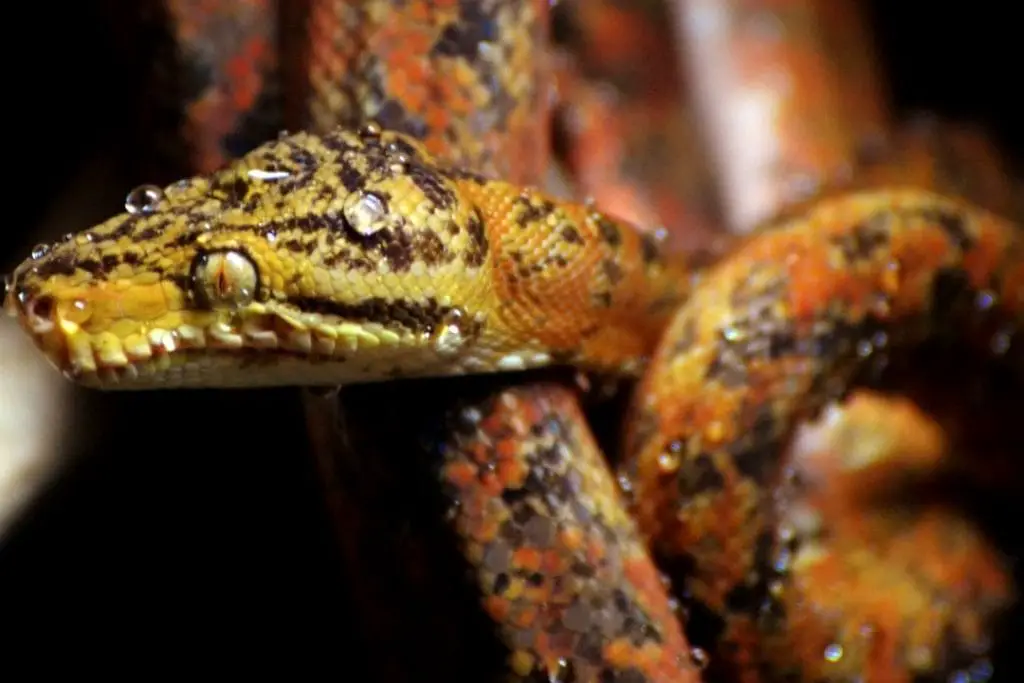
As these are tropical snakes, they need high humidity levels to remain healthy. If the enclosure is too dty, your snake may become dehydrated and begin to have serious skina dn shedding problems.
The humidity should never go below 50%. You can let it get up to 90%, particularly after a misting. Misting once a day and keeping the water dish full will help maintain humidity.
You can also add damp sphagnum moss to help maintain the humidity.
You can also place this in an enclosed hide to help ensure a healthy shed. Be sure to use a hygrometer to monitor the humidity.
Enclosure Maintenance
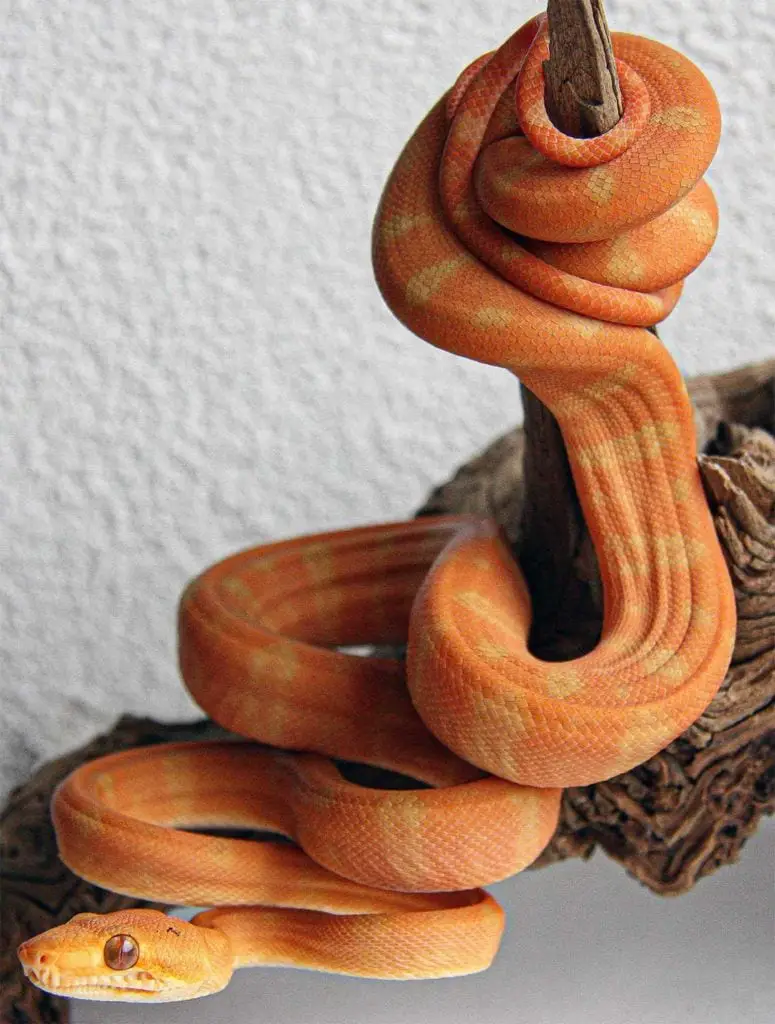
Keeping the enclosure clean is very important for your snake’s health.
A dirty enclosure will result in a sick snake. You should check for urates and feces daily and spot clean these.
You should also replace the water at least every other day or whenever it is fouled. Wash the dish once a week. Every month, remove everything to do a deep cleaning.
The first step is to turn off the heating and any lights.
Next, carefully remove your snake and place it into a temporary enclosure lined with paper towels. You can use a smaller plastic enclosure meant for the purpose or use a plastic tote with a secure lid and added ventilation holes.
Once your snake is secure, remove all the deocrations and set them aside to clean them. You will want to remove all the substrate and clean the whole enclosure.
Make sure the glass is cool or you risk cracking it if you spray a cold fluid on it. You can use a reptile-safe sanitizer to make sure the enclosure is squeaky clean.
Wipe up most of the moisture and leave the enclosure open to dry.
Then you can tackle cleaning all the decorations and hides. Anything that can’t be sanitized should likely be replaced at this stage.
You should also sanitize the water dish. Once this is done, replace all the substrate, put all the furnishings back, turn on the heating, and return your snake to its home.
Feeding
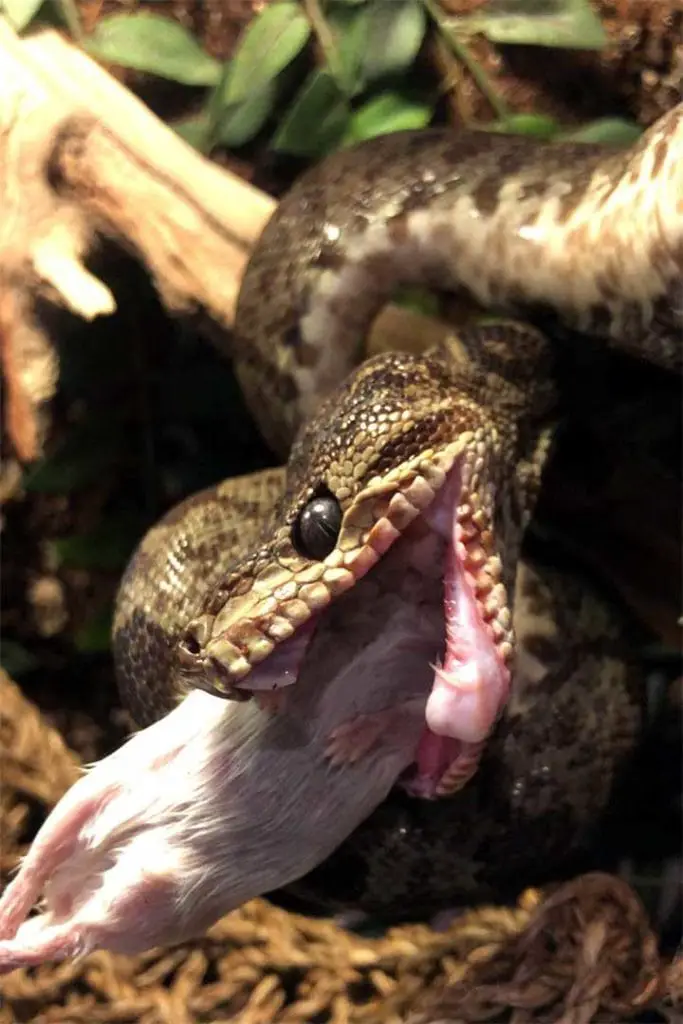
In the wild, these snakes are master of ambush hunting. they will wait on a branch and strike out at nearly any vertebrate prey that wanders by.
Most of their diet consists of birds and bats, but they will eat mammals, lizards, and even marsupials in the wild.
In captivity, these snakes are typically fed rodents since acquiring small birds is difficult and expensive. Be careful, these snakes are voracious feeders and will strike at nearly anything.
Type of Prey and Size
These snakes must be fed the right size of prey. They are slender animals and offering too large of a prey items can harm the snake in the long run.
Make sure the mouse you offer is no wider than the widest part of the snake’s body. A hatchling will typically be on pinky or fuzzy mice.
Adult amazon tree boas also need to be fed appropriately sized meals, they will feed on older mice or young rats. You should see a small lump in a snake after a meal, but they shouldn’t be too stretched out after a meal.
You should err on the smaller side since these snakes need to stay slender. You can offer other prey items like bird chicks or lizards to these snakes, but these can be expensive and difficult to find in the right size.
Frozen Vs Live

There is a real debate over which type of prey is best for snakes. We will go over this briefly so you have an idea of the options.
Live Pros:
- More natural
- Easy to get a reluctant feeder to eat live prey or pinky mice
- Slightly more nutritious
Live Cons:
- Can injure your snake
- Mice from pet stores may have parasites that your snake can get
- Have to find and house the prey until meal time
- More expensive.
Frozen Pros:
- No risk of injury or parasites
- Cheaper
- Easy to find and store
- Tree boas rarely refuse any meals
Frozen Cons:
- Some snakes may be reluctant to eat defrosted pinky mice
- Slightly less nutrition, but only small amount
Feeding live just requires that you offer the snake the prey and observe to make sure your snake isn’t injured your snake will use its heat sensing pits to detect and jump at the mouse, then constrict it.
For frozen, you can place it in the fridge the day before you want to feed your snake.
You can place the mouse in a BPA-free platic bag and immerse it in warm water to get its body temperature up to around 100 degrees before you offer it to the snake. This species can sense heat, so heating up the mouse will help ensure it will strike.
As for buying, live mice can only be acquired in person since it isn’t legal to ship live rodents.
You can buy feeder mice from pet and reptile shops, check reptile shows, and look on Facebook and Craigslist for any leftover feeder mice a local breeder may have.
Be sure you check that they have the right size of mouse beforehand. For frozen, you can buy them in all of the same places.
If you have an adult snake, this means that you can save money and stock up on months worth of food.
You can check out Layne Labs, Perfect Prey, Big Cheese Rodents, and Rodent Pro reptile trade shops for mice that will come right to your door.
Frequency
These snakes will strike at nearly anything, but you need to be careful not to overfeed.
Overfeeding and power feeding to force growth can seriously shorten the life span of these snakes. You should feed babies and juveniles once a week at most.
Adults should be fed once every 10 to 14 days. These snakes are opportunits in the wild, so they will strike any time possible, but this doesn’t mean the snake is hungry.
Since garden tree boas are ambush predators, it isn’t unusual for them to go a long time without eating. You should also aim to feed your snake in the evening since most tree boas will eat at night.
Shedding
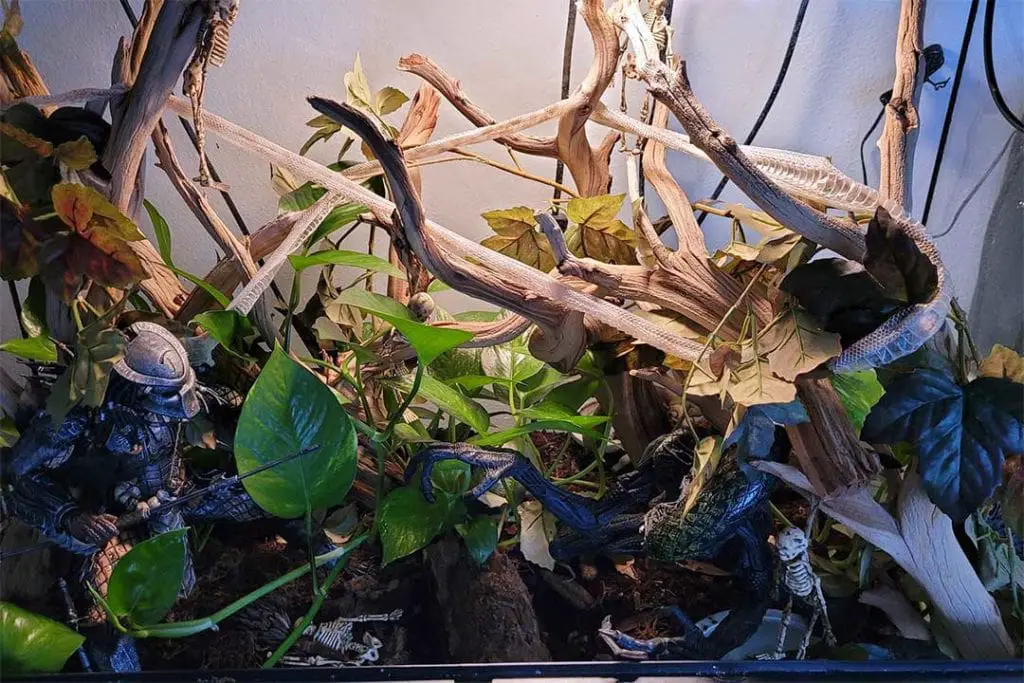
Shedding is how a snake makes room to grow.
A snake’s skin does not grow with it, so it must be shed in one big piece. When your snake is ready to shed, you will notice its colors and eyes will look dull or cloudy.
This is caused by fluid buildup that separates the old layer of skin. During this time, your snake can’t see well and will be even more snappish than usual.
You should aim for higher humidity and offer a damp hide filled with sphagnum moss to your snake when it is in this state. Your snake will seem to clear up after a few days, and you will see it rubbing on the branches and other decorations to help loosen the old skin.
Young snakes will typically shed about once a month, but adults will only shed a few times a year. Once your snake has shed, be sure to check the shed for any retained pieces.
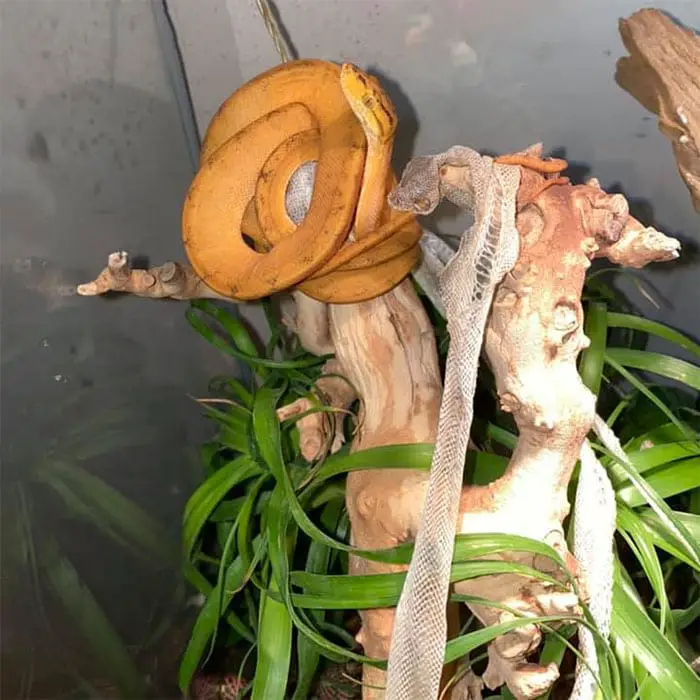
You should see both the tail tip and the scale that covers the eye of the snake. If this is missing, you will need to place your snake in a container with a warm, damp paper towel for half an hour and then you can try to remove any stuck shed with tweezers.
If it doesn’t come off easily, repeat the paper towel treatment. If you leave any shed stuck on your snake, it can cause injuries and infections.
Hibernation
Since these are tropical snakes, they do not experience a proper hibernation. Lower night time temperatures do trigger breeding responses. Unless you are breeding your snake, do not bother with this.
Handling
Amazon tree boas are typically defensive animals that never grow out of it. Captive-bred specimens are a bit more docile, but even then the animal may still bite you.
The best way to handle these snakes is with a snake hook that is long enough. These animals will bite your face if they feel threatened.
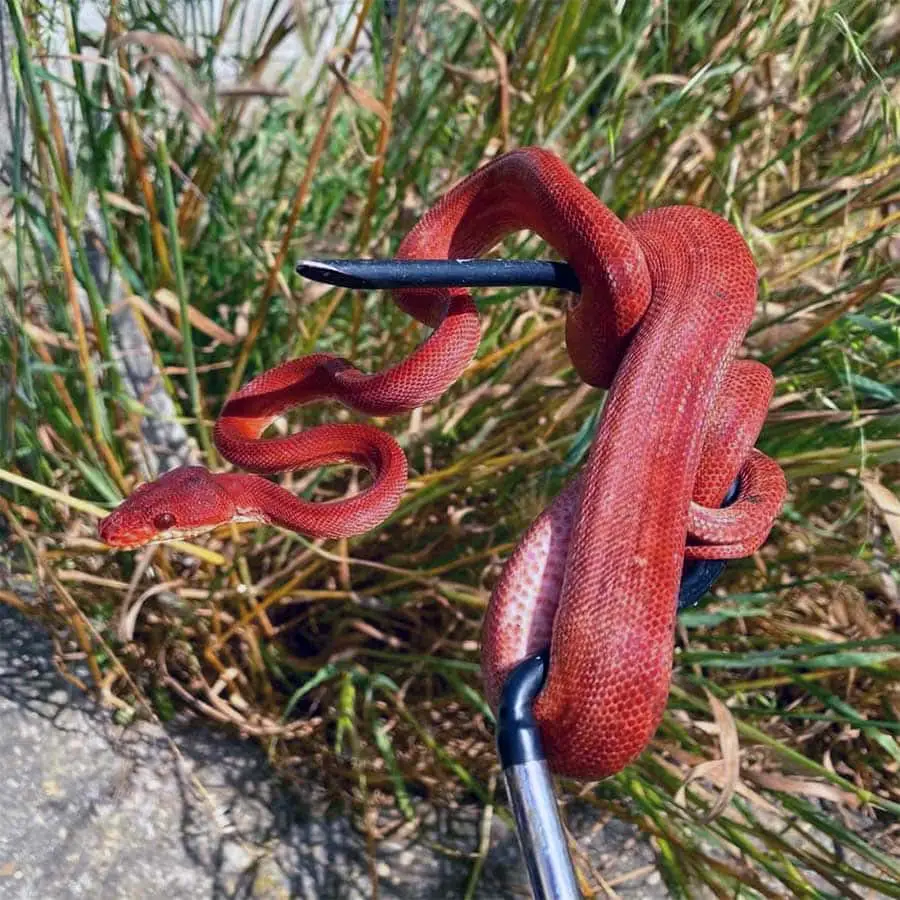
Zoo Med Collapsible Snake Hook
- Adjustable from 7-1/4 to 26″ (18cm to 66cm)
- Allows you to manipulate your snake safely, or quickly inspect cage furnishings
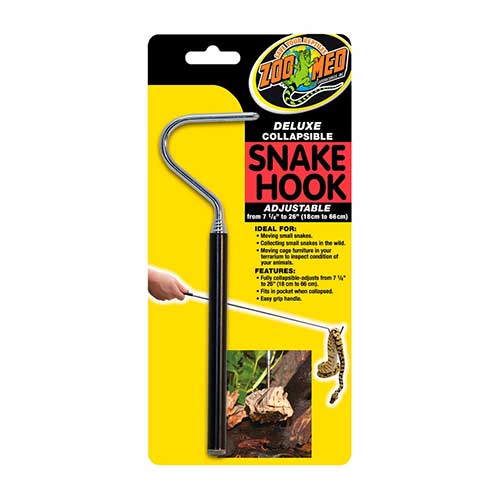
They can lunge over half their body length, so be sure you are careful and keep them away from your face using snake hooks. A glove can also be used to help make you feel more confident.
You need to approach amazon tree boas confidently since hesitation will be interpreted as you trying to eat them. Like the emerald tree boa or green tree python, these are usually not snakes you can chill with.
The goal of getting them to snap at you less often is purely to make cleaning and feeding less stressful for both of you. Just handle your snake with confidence and many individuals will become a bit less likely to bite over time.
Remember that these snakes do not have a strong bite. Most breeders say that a beesting is more painful. Be sure you do not jump back or pull away when your snake bites you.
This can injure the snake and break the jaw or teeth. If you are very nervous of being bitten, just let it bite you once so you know what to expect.
These arboreal snakes aren’t venomous so it isn’t much worse than a scratch. Remember, you will be bitten by this species. If you don’t like that, stick with a calmer snake like a corn snake, or a more classical species in the pet trade.
Some odd ones will be unusually calm and tolerate handling quite well, but don’t count on it as they are not the majority.
If you find yourself able to handle your amazon tree boa, be careful especially with juveniles as they are a rather slender snake that can easily be harmed.
Common Issues
Here we will go over some common snake troubles.
My Snake Won’t Eat
This is pretty rare for this species, these snakes tend to be very easy to feed. Make sure you have the right temperatures and humidity. Be sure your snake has sturdy places to climb and plenty of fresh water.
Make sure you have enough hides for your snake to feel secure. Check for signs of illness and parasites such as odd feces, wheezing, mucus or pus, and breathing with the mouth open.
Get your snake to a reptile vet. While they can go quite some time without eating, these snakes are typically voracious so this is concerning.
Regurgitated Food
Regurgitation can harm your snake. If your snake has regurgitated a meal, it could be stress. Make sure the animal has plenty of hides and that you leave it be after a meal.
Do not attempt to handle a snake for at least 2 days after a meal. Wait 2 weeks before you try offering another meal. If this happens repeatedly, you need to see a vet. The most common reason for repeated regurgitation is external parasites.
Respiratory Illness
Respiratory illnesses are one of the more common snake problems. Listen for strange sounds like wheezing or clicking. You snake should also not have mucus coming out of the nose or lots of it in the mouth.
If you see your snake breathing with its mouth open, take it to the vet. It is very easy to treat most respiratory problems so long as they are caught early.
Conclusion
The Corallus hortulanus (Amazon tree boa scientific name) are great display snakes, just prepare to be bitten.
These snakes are not chill buddies you can hang with, and not that common in the exotic pet trade, but still quite popular snakes with experienced keepers.
If you have any questions or comments regarding amazon tree boa care, breeding amazon tree boas, or other related topics, leave them below.
If you own one of these lovely snakes, be sure to add any tips to this amazon tree boa care sheet below.
Sources
- Animal Diversity – Corallus hortulanus
- Molecular systematics and historical biogeography of tree boas (Corallus spp.)
- Wikipedia – Corallus hortulana
- Surface structure and frictional properties of the skin of the Amazon tree boa Corallus hortulanus (Squamata, Boidae)
- A taxonomic review of the Corallus hortulanus complex of neotropical tree boas
